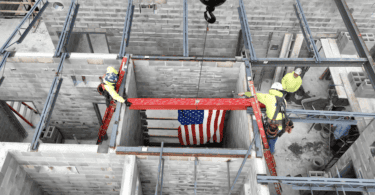by Wei Lam
If a mass timber building is to be successful, the mass timber components must be kept warm and dry throughout the building’s construction and occupancy. Project teams can achieve this by designing the building enclosure with the necessary layers to control loads on the enclosure, effectively managing moisture exposure during construction, and providing the mass timber elements an opportunity to dry out if wetted during unplanned in-service conditions.

An engineer monitors moisture content of a mass timber building component during construction. / Photo by Nelson Mouëllic Studio
Managing moisture risks in mass timber buildings and enclosures requires attention to the many sources of moisture that exist during design, manufacturing, shipping, construction, and occupancy. Long-term or persistent exposure to moisture is usually more problematic to the mass timber elements than the overall quantity of water (e.g., prolonged moisture exposure due to snowmelt). Moisture can penetrate deep into the mass timber, becoming trapped within the pore structure of the wood, and at locations such as prefabricated panel interfaces, lamination interfaces, splices, exposed end grain, and between laminations and sheathing layers. Retroactive attempts to fix these problems require tents or large-scale drying that are costly and can delay the construction schedule.
As real as these risks are, they are typically not reason to avoid mass timber building systems and the many benefits these systems provide. Rather, approaching the mass timber building through the integration of science, design, and construction with the guidance of experienced specialists who understand the considerations needed to create a durable and high-performance enclosure can significantly manage these risks.
Steps for mitigating moisture risks:
- Plan early: Start planning for moisture management in the design phase, beginning with the enclosure assemblies and intermediate floor assemblies.
- Perform a Risk Evaluation: Work with the construction team to evaluate all factors that may contribute to moisture exposure during construction and occupancy. Use this evaluation and available assembly planning tools to arrive at appropriate mass timber assemblies and protection methods, whether factory-installed or site-installed.
- Develop a Construction Phase Moisture Management Plan: Establish the plan during design to prepare the design and construction teams for managing moisture and potential exposure risks, including a response to unexpected moisture exposure.
- Execute the Design: Execute the design while also implementing the moisture management plan during construction, and continue to be responsive to wetting events.
- Monitor the Plan: Throughout the construction phase, monitor and evaluate the effectiveness of the moisture management plan through quality control and quality assurance review procedures.
 Further discussion on this approach and the referenced planning tools are provided in two industry available companion guides, Mass Timber Building Enclosure Best Practice Design Guide and Moisture Risk Management Strategies for Mass Timber Buildings, published by RDH Building Science. The latest edition of these guides will be available on Nov. 22. On Nov. 16, RDH’s building enclosure specialists will also be exploring best practice design strategies and use of these planning tools for mass timber buildings in the New England Region at the virtual Mass Timber Enclosure Symposium.
Further discussion on this approach and the referenced planning tools are provided in two industry available companion guides, Mass Timber Building Enclosure Best Practice Design Guide and Moisture Risk Management Strategies for Mass Timber Buildings, published by RDH Building Science. The latest edition of these guides will be available on Nov. 22. On Nov. 16, RDH’s building enclosure specialists will also be exploring best practice design strategies and use of these planning tools for mass timber buildings in the New England Region at the virtual Mass Timber Enclosure Symposium.
Wei Lam, PE is principal/building science specialist at RDH Building Science.











